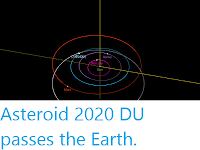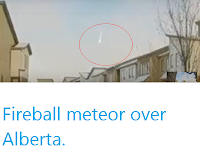Asteroid 2020 DA1 passed by the Earth at a distance of about 193 600
km (0.50 times the average distance between the Earth and the Moon, or
0.13% of the distance between the Earth and the Sun), slightly after 10.30 am
GMT on Tuesday 18 February 2020. There was no danger of
the asteroid hitting us, though were it to do so it would not have
presented a significant threat. 2020 DA1 has an estimated
equivalent
diameter of 2-7 m (i.e. it is estimated that a spherical object
with
the same volume would be 2-7 m in diameter), and an object of this
size
would be expected to explode in
an airburst (an explosion caused by superheating from friction with the
Earth's atmosphere, which is greater than that caused by simply
falling, due to the orbital momentum of the asteroid) in the atmosphere
more than 36 km above the ground, with only fragmentary material
reaching the Earth's surface.
The calculated orbit of 2020 DA1. JPL Small Body Database.
2020 DA1 was discovered on 17 February 2020 (the day before its closest encounter with the Earth) by the
University of Arizona's Mt. Lemmon Survey at the Steward Observatory on Mount
Lemmon in the Catalina Mountains north of Tucson. The designation 2020 DA1
implies that the asteroid was the 25th object (asteroid A -
in numbering asteroids the letters A-Y, excluding I, are assigned
numbers from 1 to 24, with a number added to the end each time the
alphabet is ended, so that A = 1, A1 = 25, A2 = 49, etc) discovered in the Second half of February 2020 (period 2020 D).
2020 DA1 has a 455 day orbital period and an eccentric orbit
tilted at an angle of 7.89° to the plane of the Solar System, which
takes it from 0.49 AU from the Sun (i.e. 49% of he average distance at
which the Earth orbits the Sun, slightly outside the orbit of the planet Mercury) to 1.81 AU from the Sun (i.e. 181% of
the
average distance at which the Earth orbits the Sun, and considerably outside the orbit of the planet Mars). It is therefore
classed as an
Apollo Group Asteroid (an asteroid that is on average further from the
Sun than the Earth, but which does get closer). This
means that close
encounters between the asteroid and Earth occasionally occur, with the
last having occurred in October 2012, and the next predicted for August 2021. 2020 DA1 also has occasional close encounters with the planet Venus, with the last having happened in June 1926 and the next predicted for September 2027.
See also...
Follow Sciency Thoughts on Facebook.







